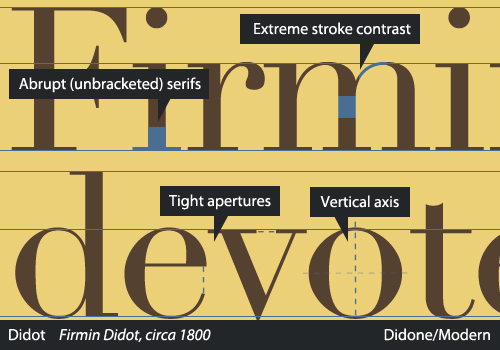Modern Typefaces
As strange as it seems, what we call modern typefaces first appeared in the second half of the 1700s. Therefore, I will call them by their less absurd name — and who can argue that saying “Didone” is not more fun than saying simply “Modern”? Bringhurst terms them Romantics.
Through the 18th and 19th centuries, France witnessed a small printing dynasty in the Didot family. Over multiple generations, the family made major contributions to printing. One of the most remarkable members was Firmin Didot, who, with Giambattista Bodoni, ushered in and now acts as a namesake for this part of type history.
In large part inspired by Baskerville, Didot and Bodoni pushed the limits of type design. They explored a similar style and were both meticulous craftsmen, consequently igniting a fierce rivalry. Bodoni (1740–1813) gave himself entirely to his craft. He was renowned for the beauty of his type specimens, and, a technically brilliant punchcutter himself, he designed some 298 typefaces. Didot (1764–1836), on the other hand, retired in 1827 to pursue political office and literature in his later years, writing tragedies and literary critiques.
If Baskerville’s stroke contrast was exaggerated, then the Didones’ are in the extreme. The heavy strokes are very heavy, and the light are a hairline. The stress is again completely vertical, and the apertures — places where the character opens — are generally very tight. Combined, these make for a very awkward visual rhythm, and Didones are always a poor choice for chunks of text. Rather, they work best at large sizes, as titling and display type, because the features emphasize the elegance of individual characters and do not blend well. Adobe’s New Caledonia, which softens some extremes and thus works for longer bits of text, is a possible exception.
Aside from the obvious Bodoni and Didot faces, in their dozens of variants from nearly every foundry, Basilia, Aviano, Walbaum, Ambroise and Scotch Roman are exemplary moderns.
Source
Alessio, Joseph. "Making Sense Of Type Classification (Part 1)." Smashing Magazine. N.p., 17 Apr. 2013. Web. 27 Apr. 2014.
